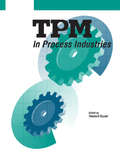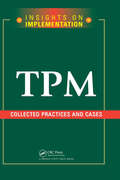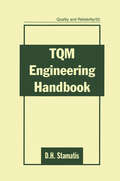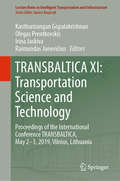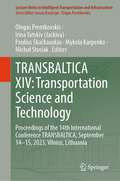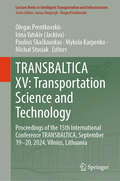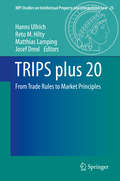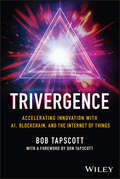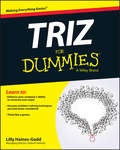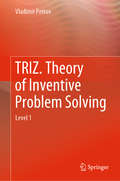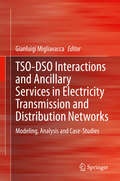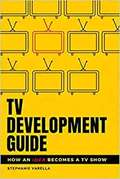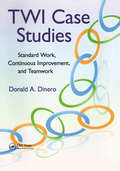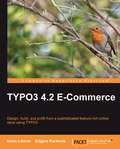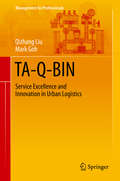- Table View
- List View
TPM in Process Industries
by Tokutaro SuzukiProcess industries have a particularly urgent need for collaborative equipment management systems, but until now have lacked for programs directed toward their specific needs. TPM in Process lndustries brings together top consultants from the Japan Institute of Plant Maintenance to modify the original TPM Development Program. In this volume, they demonstrate how to analyze process environments and equipment issues including process loss structure and calculation, autonomous maintenance, equipment and process improvement, and quality maintenance. For all organizations managing large equipment, facing low operator/machine ratios, or implementing extensive improvement, this text is an invaluable resource.
TPM: Collected Practices and Cases
by Productivity PressEquipment downtime can bring a lean manufacturing operation to a complete standstill. Total productive maintenance (TPM) is such a fundamental part of becoming lean because a machine failure at one step of a continuous flow process will halt all the steps before and after it. Strategies aimed at eliminating downtime are essential in any operation i
TQM Engineering Handbook (Quality and Reliability)
by D.H. StamatisOffering a model, an implementing strategy, as well as traditional and nontraditional methods for the successful enhancement and maintenance of quality, this work establishes a rationale for the continuation of Total Quality Management (TQM) in all organizations. It considers leading quality-related topics, such as unusual charts, supplier-organiza
TRANSBALTICA XI: Proceedings of the International Conference TRANSBALTICA, May 2-3, 2019, Vilnius, Lithuania (Lecture Notes in Intelligent Transportation and Infrastructure)
by Kasthurirangan Gopalakrishnan Olegas Prentkovskis Irina Jackiva Raimundas JunevičiusThis book gathers papers presented at the 11th international scientific conference "Transbaltica: Transportation Science and Technology", held on May 2-3, 2019 at Vilnius Gediminas Technical University, Lithuania. It covers cutting-edge issues concerning research and development of modern transport systems. The chapters, written by an international group of experts, discuss novel and smart solutions in the area of vehicle engineering, including environmentally friendly technologies, topics relating to traffic safety, modeling and control, and solutions and challenges in modern logistics. Further topics include multimodal transport and vehicle automation. Providing comprehensive information and ideas concerning innovative transportation technologies and challenges, this book offers a valuable resource for transportation researchers and practitioners, including engineers, managers and decision-makers in the field.
TRANSBALTICA XIV: Proceedings of the 14th International Conference TRANSBALTICA, September 14-15, 2023, Vilnius, Lithuania (Lecture Notes in Intelligent Transportation and Infrastructure)
by Irina Yatskiv Olegas Prentkovskis Paulius Skačkauskas Mykola Karpenko Michał StosiakThis book reports on innovative research and developments in the broad field of transportation. It covers innovative solutions relating to intelligent vehicles and infrastructure, energy and combustion management, vehicle dynamics and engineering. It also reports on advances in railway transport, air transportation, as well as transportation safety and logistics. Chapters are based on peer-reviewed papers presented at the 14th international scientific conference "Transbaltica: Transportation Science and Technology", held on September 14-15, 2023, at Vilnius Gediminas Technical University, in Vilnius, Lithuania. All in all, this book offers extensive and timely information to both researchers and practitioners in the field of transportation, logistics and related interdisciplinary areas.
TRANSBALTICA XV: Proceedings of the 15th International Conference TRANSBALTICA, September 19–20, 2024, Vilnius, Lithuania (Lecture Notes in Intelligent Transportation and Infrastructure)
by Irina Yatskiv Olegas Prentkovskis Paulius Skačkauskas Mykola Karpenko Michał StosiakThis book reports on innovative research and developments in the broad field of transportation. It covers innovative solutions relating to intelligent vehicles and infrastructure, energy and combustion management, vehicle dynamics and engineering. It also reports on advances in railway transport, air transportation, as well as transportation safety and logistics. Chapters are based on peer-reviewed papers presented at the 15th international scientific conference "Transbaltica: Transportation Science and Technology", held on September 19–20, 2024, in person at Vilnius Gediminas Technical University, in Vilnius, Lithuania, and also online. All in all, this book offers extensive and timely information to both researchers and practitioners in the field of transportation, logistics and related interdisciplinary areas.
TRIPS plus 20
by Josef Drexl Reto M. Hilty Hanns Ullrich Matthias LampingThis book examines the impact and shortcomings of the TRIPS Agreement, which was signed in Marrakesh on 15 April 1994. Over the last 20 years, the framework conditions have changed fundamentally. New technologies have emerged, markets have expanded beyond national borders, some developing states have become global players, the terms of international competition have changed, and the intellectual property system faces increasing friction with public policies. The contributions to this book inquireinto whether the TRIPS Agreement should still be seen only as part of aninternational trade regulation, or whether it needs to be understood - or even reconceptualized- as a framework regulation for the international protection of intellectualproperty. The purpose, therefore, is not to define the terms of an outright revision of theTRIPS Agreement but rather to discuss the framework conditions for an interpretative evolutionthat could make the Agreement better suited to the expectations and needs of today's globaleconomy.
TRIVERGENCE: Accelerating Innovation with AI, Blockchain, and the Internet of Things
by Bob TapscottA Breakthrough Introduction to The Next Phase of the Digital Age In Trivergence, Bob Tapscott, writer, speaker, complex system designer, and former CIO introduces an exciting new concept in explaining how the intersection of artificial intelligence (AI), blockchain, and the Internet of Things (IoT) will transform business and society. He explains the synergies between these technologies and the disruptive potential that they will offer, as well as the challenges and risks to making it happen. He offers an insightful guide through the difficult decisions that businesses and society must make to thrive in a new era where decisions will be difficult, and uncertainties abound. You'll discover how and why AI's power is now exploding, its growth driven by smarter approaches to neural networks trained on a new hardware architecture that can derive its intelligence from ever more massive datasets. You'll also find: Discussions of the multiplicative and exponential power of trivergence on the core technologies discussed in the book Explorations of IoT's tendency to bring the physical world to life as it harnesses the capabilities of AI and the blockchain How trivergence morphs Big Data into something new he calls “Infinite Data”, where thinking machines consider trillions of data points to generate their own content, value, and perspectives without programmed code or human intervention A fresh and innovative guide, rich with case stories, on how the most critical technologies of this new phase in the digital age are combining to drive business transformation, Trivergence will become a critical handbook for forward-looking leaders, and anyone interested in the intersection of cutting-edge tech and business.
TRIZ For Dummies
by Lilly Haines-GaddUse TRIZ to unlock creative problem solving Are you new to TRIZ and looking for an easy-to-follow guide on how you can use it to enhance your company's creativity, innovation and problem-solving abilities? Look no further! Written in plain English and packed with tons of accessible and easy-to-follow instruction, TRIZ For Dummies shows you how to use this powerful toolkit to discover all the ways of solving a problem, uncover new concepts and identify previously unseen routes for new product development. An international science that relies on the study of patterns in problems and solutions, TRIZ offers a powerful problem-solving and creativity-generating solution for companies looking to promote innovation, especially in the face of having to do more with less. Inside, you'll find out how to successfully apply this problem-solving toolkit to benefit from the experience of the whole world—not just the spontaneous and occasional creativity of individuals or groups of engineers with an organisation. Learn to think like a genius with TRIZ Discover the benefits of TRIZ as a tool for businesses Find fun and simple exercises for putting TRIZ into practise Benefit from industry examples of where TRIZ has worked—and how With the help of TRIZ For Dummies, you'll get the skills needed to see the wood for the trees and solve complex problems with creativity, ingenuity and innovation.
TRIZ in Latin America: Case Studies
by Guillermo Cortes RoblesThis book describes the adoption process of TRIZ under challenging conditions and under serious limitations. It presents the integration of TRIZ with other techniques to solve problems in the Latin America industry. The chapters contain some industrial cases that explain the adoption process of TRIZ. They also describe the restrictions or limits on the use and adoption of TRIZ. This book describes a strategy to apply the TRIZ tools for product or service design. Case studies from different universities and enterprises are presented to facilitate the assimilation of the TRIZ concepts and tools.
TRIZ-Anwendertag 2020
by Oliver MayerTRIZ is a valuable tool for inventive problem solving. Based on patent analysis TRIZ enables the faster solution-oriented generation of ideas in fields of technology, organizations, and software. Still TRIZ is not the only way that leads to innovation. There are more tools and each of them has its own pros and cons. Combining them is the key to success. The 1st TRIZ online conference by Bayern Innovativ was born from the TRIZ-Anwendertage. The idea behind is providing a platform that allows to discuss and display TRIZ development in the context of innovation methodology. This book presents papers in German and English language on how TRIZ is related to other tools like Design Thinking, the St. Gallen Business models, etc.
TRIZ-Anwendertag 2022
by Oliver MayerTRIZ is a valuable tool for inventive problem solving. Based on patent analysis TRIZ enables the faster solution-oriented generation of ideas in fields of technology, organizations, and software. TRIZ originated from mainly mechanical problems. But it can be applied very successfully as well for other branches like business, or sustainability or in traffic planning. This enlarged application range offers supplementary value of the tool box TRIZ. The 2nd TRIZ online conference by Bayern Innovativ was born from the TRIZ-Anwendertage. The idea behind is providing a platform that allows to discuss and display TRIZ development in the context of innovation methodology. This book presents papers in English & German language on how TRIZ is related to other tools like Design Thinking, the St. Gallen Business models, etc. and to different areas of application, not only electro-mechanical.
TRIZ-Anwendertag 2024
by Oliver MayerTRIZ is a valuable tool for inventive problem solving. Based on patent analysis TRIZ enables the faster solution-oriented generation of ideas in fields of technology, organizations, and software. TRIZ originated from mainly mechanical problems. But it can be applied very successfully as well for other branches like business, sustainability, with Artificial Intelligence (AI). This enlarged application range offers supplementary value of the toolbox TRIZ. The 3rd TRIZ online conference by Bayern Innovativ was born from the TRIZ-Anwendertage. The idea behind is providing a platform that allows to discuss and display TRIZ development in the context of innovation methodology. This book presents papers in English and German language according to the motto “TRIZ beyond tomorrow: actual trends and visions for the future“. At the TRIZ Conference online, the focus is on new applications, research and extensions of the TRIZ methodology. It is mainly attended by companies, research institutions, colleges, universities and aspirants for TRIZ L4 and L5 who are further developing TRIZ or combining it with other methods and in other areas such as quality assurance, business models, sustainability issues, etc.
TRIZ. Theory of Inventive Problem Solving: Level 1
by Vladimir PetrovThis introductory book describes the initial (first) level of studying the theory of inventive problem solving (TRIZ) from the series “TRIZ from A to Z,” and presents the most general methods for solving inventive problems and generating new ideas. Chapter 1 examines traditional technologies for problem solving, based on trial and error. Chapter 2 describes the general concept of TRIZ, while Chapter 3 explains the main notions of “system” approaches, like system thinking, system and its hierarchy, system effect, emergency, synergetic effect and systematicity. In turn, Chapter 4 describes the notion of “ideality” and Chapter 5 addresses the notion of resources, their types, and methods for using them. Chapter 6 acquaints readers with one of the most important aspects of TRIZ: contradiction. Chapter 7 describes the inventive principles, while Chapter 8 includes descriptions of the systems of trends proposed by G. Altshuller and the author. In closing, the author makes recommendations on how to most effectively use TRIZ tools, on how readers can improve their knowledge, skills and habits concerning the use of TRIZ, and on how they can hone their inventive thinking skills. The book also features Appendices that include analyses of selected problems, a list of the main websites related to TRIZ, and lists of examples, problems, illustrations, tables and formulae.
TSA Baggage: An Inside Look at the Good, the Bad, and the Ugly at America's Airports
by Scott BeckerScott Becker spent over 12 years working for the TSA at Chicago’s O’Hare airport and served it in numerous capacities, from baggage screener to manager. He brings to TSA Baggage a wealth of experience and stories that have something for everyone:•Candid Cameos: Several stories in TSA Baggage feature appearances from celebrities, including Madeleine Albright, Patch Adams, and the Kardashians•Behind-the-Scenes Look: For anyone who’s ever wondered what happens in the parts of airports hidden from a view or during a shift at a security check, this book provides first-hand accounts of the inner workings of airports and the people who keep them humming•Laugh Track: Airports seem to attract the misguided, confused, and weird, and this provides for plenty of laughs, whether its passengers attempting to bring grenades in their luggage or trying to skip through security in a drunken tizzy•Travel Warning: This book can also be a great guide to do’s and don’ts for all future travelers, with tips from someone who’s seen everything that can go right and wrong at an airportTravel brings out the good, bad, and ugly in everyone, and TSA Baggage captures all of it for readers from a first-hand witness to the whole circus. Strap in and get ready for a great read.
TSG Hoffenheim: Football in the Age of Analytics
by Feng Zhu Karim R. Lakhani Kerry Herman Sascha L. SchmidtIn 2015, Dietmar Hopp, owner of Germany's Bundesliga football team TSG Hoffenheim and co-founder of the global enterprise software company SAP, was considering how to ensure long-term sustainability and competitiveness for TSG Hoffenheim. While historically a small team from bottom rungs of the league, TSG Hoffenheim, with revenues of €60 million to €70 million, reached the top division of the Bundesliga in the 2008–2009 season thanks to a deliberate strategy focused on enhanced scouting, strong youth programs, and innovative technology and analytics that improved player development. In 2014 Hopp, who had personally invested €300 million in the club, built a "footbonaut," an automated training environment that collected data on players' skills and strengths. The tool, one of three in the world, helped scouts and coaches better assess and develop each player. Yet some managers felt the technology was a distraction, an investment too expensive for a team that was not yet cash-flow positive. The team finished the 2014–2015 season in eighth place, below the top division, and Hopp wondered whether the focus on technology and analytics was the right strategy to grow the club. He wondered if the "moneyball" approach—when a smaller team competed with wealthier teams by using statistical analysis to buy undervalued assets and sell overvalued assets—could work in football and if investments in technology could lead the team to financial independence.
TSG Hoffenheim: Football in the Age of Analytics (B)
by Feng Zhu Karim R. Lakhani Sascha L. Schmidt Sebastian KoppersIn 2015, Dietmar Hopp, owner of Germany's Bundesliga football team TSG Hoffenheim and co-founder of the global enterprise software company SAP, was considering how to ensure long-term sustainability and competitiveness for TSG Hoffenheim. While historically a small team from bottom rungs of the league, TSG Hoffenheim, with revenues of 60 million to 70 million, reached the top division of the Bundesliga in the 2008-2009 season thanks to a deliberate strategy focused on enhanced scouting, strong youth programs, and innovative technology and analytics that improved player development. In 2014 Hopp, who had personally invested 300 million in the club, built a "footbonaut," an automated training environment that collected data on players' skills and strengths. The tool, one of three in the world, helped scouts and coaches better assess and develop each player. Yet some managers felt the technology was a distraction, an investment too expensive for a team that was not yet cash-flow positive. The team finished the 2014-2015 season in eighth place, below the top division, and Hopp wondered whether the focus on technology and analytics was the right strategy to grow the club. He wondered if the "moneyball" approach-when a smaller team competed with wealthier teams by using statistical analysis to buy undervalued assets and sell overvalued assets-could work in football and if investments in technology could lead the team to financial independence.
TSO-DSO Interactions and Ancillary Services in Electricity Transmission and Distribution Networks: Modeling, Analysis and Case-Studies
by Gianluigi MigliavaccaThis book presents new and practical solutions to solve the coordination problem faced due to the increasing integration of renewable energy sources into existing electricity transmission networks it addresses how the subsequent technological revolution is not only affecting the structure of the electricity markets, but also the interactions between transmission system operators (TSO) and distribution system operators (DSO). A must-have for smart grid analysis, this book presents models and scenario buildups of complex systems and incorporates the experience of three technological pilots that are analyzing special issues connected to network monitoring and control, and participation to a would-be ancillary services market from special subjects. The reader will benefit from the experience drawn from SmartNet, a major research project encompassing 22 partners from nine EU countries and including input gathered from a significant number of industrial partners.
TV Development Guide: How an Idea Becomes a TV Show
by Stephanie VarellaThis is THE ONLY BOOK that takes you through the TV Development process and shows how an idea becomes a TV show in Hollywood. The "TV Development Guide: How an Idea Becomes a TV Show" is perfect for anyone thinking about getting into the TV business, just starting out or already in it and looking for some insight and guidance for their projects. It's a step-by step guide to understand the TV business, how TV development works which includes how to develop your idea, script development, pitching, strategies on selling your show, and more. There are also several interviews with top development executives and agents in the industry.
TWA Parts (Abridged)
by V. G. NarayananTransworld Auto Parts had to implement its new strategy flawlessly to survive the auto industry upheaval. The new CEO asked her leadership team to craft strategy maps and balanced scorecards to help each division implement its strategies.
TWI Case Studies: Standard Work, Continuous Improvement, and Teamwork
by Donald A. DineroTWI Case Studies: Standard Work, Continuous Improvement, and Teamwork provides the insight of leading experts to assist in the execution of Training Within Industry (TWI) the game-changing business tool. Presented as a series of case studies from a range of corporations with a variety of products and needs, it illustrates the rebirth of TWI program
TYPO3 4.2 E-Commerce
by Edgars KarlsonsThis is a fast-paced tutorial focusing on creating an online store. It walks in detail through development of a sample website, illustrating each step with screenshots and explanation. The cumbersome and time-consuming task of developing and customizing a TYPO3 e-commerce site will be a smooth sail with this book. If you want to create a captivating online shop using TYPO3 and optimize your profit, this book is for you. Some knowledge of TYPO3, PHP, and TypoScript is required.
Ta-q-bin
by Mark Goh Qizhang LiuThis book reveals the secrets of Yamato Transport's success in maintaining and extending its leadership in Japan's domestic parcel delivery market. It presents six cases that illustrate how Yamato's flagship service, TA-Q-BIN, has evolved since the 1970s to the benefit of consumers, particularly urban dwellers, and how TA-Q-BIN has become an integral part of Japanese daily life. Each of the six unique cases serves as an independent teaching case for undergraduate and graduate students, describing the particular service design, operations management, innovation, supplier management, and social responsibility within the context of an Asian last-mile logistics service provider. The book also includes insightful presentations of the challenges facing supply chain and logistics service providers in Asia, and their innovative responses to these challenges using real-world cases. Besides featuring interviews with Yamato's key stakeholders and their strategic clients, Japan-based and other Asia-Pacific Yamato operational centers make up the field method included in this book, while secondary data is drawn from trade and academic domains. Some of the cases are written in a didactic fashion, with suitable stopping points for students to pause and deliberate over the managerial issues confronting the decisions that Yamato makes during the course of its business and operational strategies. The results are particularly useful to readers interested in how operations and logistics decision-making are practiced in a homogeneous Asian context and in an urban environment. This book is essential reading for undergraduate and MBA students, as well as practitioners in industry.
TaKaDu
by Elie Ofek Matthew PrebleIn December 2012, Amir Peleg, founder and CEO of TaKaDu, reflected on how to position his young firm for the next fiscal year and beyond. The small Israeli startup had developed an innovative software system that used patented algorithms and statistical analysis to detect problems such as leaks, bursts, and faulty equipment within a water utility's infrastructure. Such problems caused significant water and energy loss at many utilities, led to service interruptions for consumers, and were only getting worse as the existing infrastructure aged. Since its founding in 2009, TaKaDu had attracted nine customers from around the world. However, as Peleg and his executive team debated how to allocate funding for the upcoming year, he needed to decide whether to focus on R&D to improve and add to TaKaDu's existing software and become the clear technology leader, or move ahead with its current offering and focus on getting new customers to penetrate the market as quickly as possible before competition intensified. Some in the company called for devoting the bulk of TaKaDu's resources to making the system more easily deployable, as deploying the TaKaDu service with a new customer could take up to two months. Peleg also wondered if the company should continue to pursue sales leads from anywhere in the world, or focus on one geographic market (and if so, what region should he choose)? An Australian water utility had made a public announcement it was accepting bids to implement a smart water network monitoring system and Peleg wanted to discuss if and how aggressively TaKaDu should bid on the contract with his management team. TaKaDu already had one Australian customer, was this the region to focus on?
Table Tactics: How to Play the Game Well
by Harvard Business Review PressThe first challenge in negotiation is to get the other side to the table. After offering methods of getting the ball rolling, this chapter covers ways to relieve tension, agree on an agenda, and set the right tone. The remainder of the chapter focuses on table tactics for the negotiations themselves, including active listening, exploiting complementary interests, packaging options for more favorable deals, and continual evaluation.
